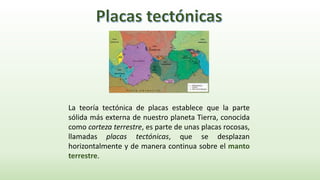PLACAS TECTONICAS
Una placa tectónica o placa litosférica es un fragmento de litosfera que se mueve como un bloque relativamente rígido sobre la astenosfera (manto superior) de la Tierra. La palabra tectónica deriva del griego antiguo τέκτων, τέκτωνος: nominativo y genitivo de singular de constructor, carpintero, y del sufijo ικα: relativo a.1 La tectónica de placas es la teoría que explica la estructura y dinámica de la superficie terrestre. Establece que la litosfera (la zona dinámica superior más externa y rígida de la Tierra) está fragmentada en una serie de placas que se desplazan sobre la astenosfera.[cita requerida] Esta teoría también describe el movimiento de las placas, sus direcciones e interacciones. La litosfera terrestre está dividida en grandes placas y en otras menores o microplacas. En los bordes de las placas se concentra actividad sísmica, volcánica y tectónica. Esto da lugar a la formación de grandes cadenas y cuencas.

Recomendados
Recomendados
Más contenido relacionado
Destacado
Destacado (20)
PLACAS TECTONICAS
- 1. La teoría tectónica de placas establece que la parte sólida más externa de nuestro planeta Tierra, conocida como corteza terrestre, es parte de unas placas rocosas, llamadas placas tectónicas, que se desplazan horizontalmente y de manera continua sobre el manto terrestre.
- 2. Los lugares de mayor actividad tectónica corresponden a las zonas donde los bordes de las placas chocan. Existen tres clases de bordes. Convergentes Divergentes Transformantes
- 3. Ocurren cuando los bordes de dos placas tectónicas chocan y una se desliza debajo de la otra. Existen tres tipos de convergencia: (1) obducción, que es el choque de dos placas continentales; (2) subducción, que es el choque de una placa continental con otra oceánica; y (3) dorsal marino, que es el choque de dos placas oceánicas. Obducción Subducción Dorsal marino
- 4. Ocurren cuando los bordes de dos placas tectónicas se alejan y el vacío que resulta de esta separación se rellena con material que surge del magma de las capas inferiores de la corteza terrestre. Si dos placas oceánicas divergen, se constituyen los océanos. En cambio, si divergen dos placas continentales, se forma un enorme valle denominado rift continental.
- 5. Ocurren cuando los bordes de dos placas tectónicas se encuentran contiguas pero no chocan de frente, sino que se deslizan paralelamente en direcciones opuestas. Este fenómeno se conoce como falla. Un ejemplo es la falla de San Andrés, en California (EE. UU.), donde el desplazamiento suele ser súbito y provoca fuertes terremotos.